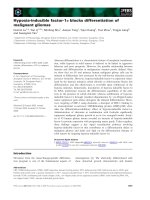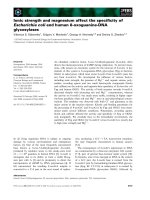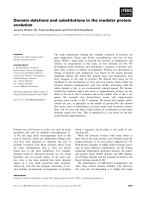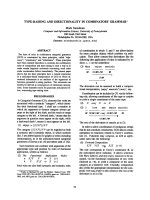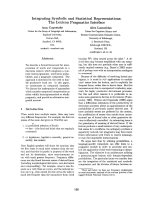báo cáo khoa học: "Concurrent insulinoma and pancreatic adenocarcinoma: report of a rare case and review of the literature" pdf
Bạn đang xem bản rút gọn của tài liệu. Xem và tải ngay bản đầy đủ của tài liệu tại đây (2.19 MB, 3 trang )
CAS E REP O R T Open Access
Concurrent insulinoma and pancreatic
adenocarcinoma: report of a rare case and
review of the literature
Panagiotis G Athanasopoulos
1*
, George Polymeneas
1
, Dionysios Dellaportas
1
, George Mastorakos
2
, Evi Kairi
3
,
Dionysios Voros
1
Abstract
Pancreatic adenocarcinoma is the 5th leading cause of cancer-related death in Western countries and insulinomas
are rare endocrine neoplasms of the pancreas. The concurrent appearance of pancreatic adenocarcinoma and
insulinoma is very rare and to the best of our knowledge has never been reported again. Herein, we present such
an occurrence in a 74-year-old man. Resection of a mass in the uncinate process of the pancreas revealed
pancreatic adenocarcinoma with severe desmoplastic reaction. Two years later, due to symptomatology persistence
the patient was re-examined and a new 2cm mass in the uncinate process was found leading to surgery, which
demonstrated a 2cm endocrine islet-cell tumor. Establishing a diagnosis in patients with insulinoma is difficult and
the imaging studies still have low sensitivity and specificity except for intra-operative ultrasonography, which is the
most accurate method detecting 90% of these lesions.
Background
Pancreatic endocrine neoplasms are rare tumours with a
reported incidence of four cases per million patients per
year [1]. Of these tumours, insulinomas are the most
common and typically are sporadic and solitary masses
affecting individuals 30-60 years old, with equal distribu-
tion among genders [2]. On the other hand, pancreatic
adenocarcinoma is the 5th leading cause of cancer death
in Western count ries, and the second cause of cancer
death among gastrointest inal tumors [3]. An unusual
occurrence of concomitant pancreatic adenocarcinoma
and insulinoma in a 74-year-old man is presented
herein.
Case Presentation
A 74-year-old man was admitted to our hospital , suffer-
ing for the last 2 years from hypoglycaemic attacks.
Laboratory tests showed fasting glucose level below
50mg/dl and symptoms of hyp oglycaemia such as tachy-
cardia, sweating, confusion and light-headedness. The
correction of the above when glucose was administered
was significant, so the Whipple’striadwaspresent.
Plasma-insulin level, measured through the extended
72-hours f asting test was found 12mIU/ml and C-pep-
tide level was also elevated, 4.3ng/ml. Tumour markers
were within normal range apart from Ca 19-9 which
was 5IU/ml.
Abdominal ultrasonography (US) did not reveal any
lesion, but a contrast enhanced CT scan demonstrated a
1.5cm solid mass in the uncinate process of the pancreas
(Figure 1). The patient underwent surgical exploration
and pancreas palpation indeed revealed a small solid
mass in the uncinate process, which was resected with a
small amount of normal tissue surrounding the mass. No
frozen section biopsy was done since we believed that the
mass represented t he insulinoma. However, the histo-
pathological study featured a pancreatic adenocarcinoma
of about 1mm in maximum diameter with intense
desmoplastic reaction around the lesion (Figure 2). We
estimated that the performed resection was enough treat-
ment for such a small carcinoma. The patient’spost-
operative course was uneventful and he was discharged
on the seventh postoperative day with a regular follow-up
as the only recommendation.
* Correspondence:
1
Department of Surgery, University of Athens, Aretaieion University Hospital,
76 Vas. Sofias Ave., 11528, Athens, Greece
Full list of author information is available at the end of the article
Athanasopoulos et al. World Journal of Surgical Oncology 2011, 9:7
/>WORLD JOURNAL OF
SURGICAL ONCOLOGY
© 2011 Athanasopoulos et al; licensee BioMed Centra l Ltd. This is an Ope n Acces s article distributed under the terms of the Creative
Commons Attribution License ( which permits unrest ricted use, distribution, and
reproduction in any medium, provided the original work is properly cited.
Serial evaluation of Ca 19-9, at 3-month intervals, dur-
ing the following two years, was found wit hin normal
range. Due to persistence of hypoglycaemic symptoms,
successive abdominal CT scans completed the follow-up
[4] but they were inconclusive because of the increased
postoperative inflammatory reaction in the region of the
resection. Thus, hypoglycaemic symptoms were classi-
fied as idiopathic and were significantly improved with
appropriate dietary modifications. After two years, better
CT image resolution presumably due to regression of
the inflammatory phenomena, rendered the insulinoma
mass detectable again, having at that time increased its
size from 1.5cm to 2cm (Figure 3). Another operation
was decided and pancreaticoduodenectomy was per-
formed. The histopatho logical examination revealed a
2cm endocrine islet-cell tumour (Figure 4, 5) and the
patient was discharged on the tenth postoperative day.
Discussion
The main clin ical symptom in insulinoma patients is the
inability to suppress insulin secretion in the presence of
hypoglycaemia, resulting in neuroglycopenia and adrener-
gic manifestations like headache, confusion, visual trou-
bles, shivering, irritability and palpitations [5]. However,
establishing a diagnosis in patients with insulinoma is diffi-
cult and the imaging studies still have low sensitivity and
specificity. The sensitivity of abdominal US is 50% whereas
in contrast enhanced CT scan is 24%, in MRI scan is 40%
and in scintigraphy using octreotide approaches 60%.
Endoscopic US is the most accurate non-interventional
imaging modality detecting 77% of the pancreatic insulino-
mas [6,7]. However, intraoperative US is even more accu-
rate detecting 90% of these lesions, which are usually
smaller than 2cm in maximum diameter [8].
Figure 1 Contrast enhanced CT scan depicting the 1.5 cm solid
mass in the uncinate process of the pancreas (arrow).
Figure 2 Microscopic focus of pancreatic adenocarcinoma with
desmoplastic reaction (Hematoxylin-Eosin × 400).
Figure 3 Contrast enhanced CT sc an, after the first operation,
demonstrating a 2 cm mass in the uncinate pancreatic
process, with characteristics of an endocrine neoplasm (arrow).
Figure 4 Pancreatic endocrine tumour ("insulinoma”) adjacent
to the pancreatic parenchyma (Hematoxylin-Eosin × 100).
Athanasopoulos et al. World Journal of Surgical Oncology 2011, 9:7
/>Page 2 of 3
In our case, palpation of t he lesion in the uncinate
process during the first operation thought to be the
mass, which had been demonstrated on the preoperative
abdominal CT. Unfortunately, we missed the 1.5cm
insulinoma and the resected area revealed a 1mm pan-
creatic adenocarcinoma with severe desmoplastic reac-
tion in the surrounding tissue, which when palpated
obviously misled us to believe that it corresponded to
the insulinoma. The patient’s symptoms pertained and
serial CT scans revealed the 2cm insulinoma which was
successfully treated with a Whipple’s procedure.
Mixed pancreatic tumours, either collision or compo-
site ones, from endocrine and exocrine cells have been
reported in the literature [9], as well as the coexistence
of insulinoma and gastrointestinal stromal tumours
especially in patients with neurofib romatosis type I [10].
However, the concurrence of pancreatic adenocarcinoma
and insulinoma has never been reported before.
Conclusions
The coexistence of pancreatic adenocarcinoma and insuli-
noma is very rare and has never been reported before.
Clinical symptoms should be evaluated carefully and since
imaging modalities have low sensitivity and specificity in
detecting small endocrine neoplasms, sequential imaging
studies and intraoperative US can prove very helpful.
Consent
Written informed consent was obtained from the patient
for publication of this case report and any accompanying
images. A copy of the written consent is available for
review by the Editor-in-Chief of this journal.
Author details
1
Department of Surgery, University of Athens, Aretaieion University Hospital,
76 Vas. Sofias Ave., 11528, Athens, Greece.
2
Unit of Endocrinology, University
of Athens, Aretaieion University Hospital, 76 Vas. Sofias Ave., 11528, Athens,
Greece.
3
Department of Pathology , University of Athens, Aretaieion
University Hospital, 76 Vas. Sofias Ave., 11528, Athens, Greece.
Authors’ contributions
PA participated in the surgical procedure, conceived and designed the
study, and wrote the manuscript. GP analysed the data and drafted critically
the manuscript. DD participated in the surgical procedure, acquired the data
and helped in writing the manuscript. GM helped in the acquisition and
interpretation of data, and he drafted the manuscript. EK performed the
appropriate histological analysis of the surgical specimens and provided
histological sections as figures for the manuscript. DV carried out the
surgical procedure, participated in designing the study and finally revised
the manuscript for submission. All authors read and approved the final
manuscript.
Competing interests
The authors declare that they have no competing interests.
Received: 9 November 2010 Accepted: 25 January 2011
Published: 25 January 2011
References
1. Service FJ, McMahon MM, O’Brien PC, Ballard DJ: Functioning insulinoma-
incidence, recurrence and long-survival of patients: a 60-year study.
Mayo Clin Proc 1991, 66:711-719.
2. Kuzin NM, Egorov AV, Kondrashin SA, Lotov AN, Kuznetzov NS, Majorova JB:
Preoperative and intraoperative topographic diagnosis of insulinomas.
World J Surg 1998, 22:593-597.
3. Jemal A, Murray T, Ward E, Samuels A, Tiwari RC, Ghafoor A, Feuer EJ,
Thun MJ: Cancer statistics, 2005. CA Cancer J Clin 2005, 55:10-30.
4. Zervos EE, Rosemurgy AS, Al-Saif O, Durkin AJ: Surgical management of
early-stage pancreatic cancer. Cancer Control 2004, 11:23-31.
5. Grant CS: Gastrointestinal endocrine tumours. Insulinoma. Baillieres Clin
Gastroenterol 1996, 10:645-671.
6. Grant CS: Surgical aspects of hyperinsulinemic hypoglycemia. Endocrinol
Metab Clin North Am 1999, 28:533-554.
7. Gibril F, Reynolds JC, Doppman JL, Chen CC, Venzon DJ, Termanini B,
Weber HC, Stewart CA, Jensen RT: Somatostatin receptor scintigraphy: its
sensitivity compared with that of other imaging methods in detecting
primary and metastatic gastrinomas. A prospective study. Ann Intern Med
1996, 125:26-34.
8. Hashimoto LA, Walsh RM: Preoperative localization of insulinomas is not
necessary. J Am Coll Surg 1999, 189:368-373.
9. Capella C, La Rosa S, Uccella S, Billo P, Cornaggia M: Mixed endocrine-
exocrine tumors of the gastrointestinal tract. Semin Diagn Pathol 2000,
17:91-103.
10. Teramoto S, Ota T, Maniwa A, Matsui T, Itaya N, Aoyagi K, Kusanagi H,
Narita M: Two von Recklinghausen’s disease cases with
pheochromocytomas and gastrointestinal stromal tumors (GIST) in
combination. Int J Urol 2007, 14:73-74.
doi:10.1186/1477-7819-9-7
Cite this article as: Athanasopoulos et al.: Concurrent insulinoma and
pancreatic adenocarcinoma: report of a rare case and review of the
literature. World Journal of Surgical Oncology 2011 9:7.
Figure 5 Pancreatic endocrine tumour, intensely immunostained
for insulin (x 100).
Athanasopoulos et al. World Journal of Surgical Oncology 2011, 9:7
/>Page 3 of 3

